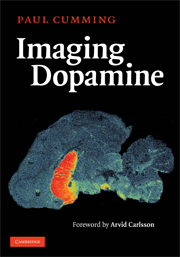Book contents
- Frontmatter
- Contents
- Foreword
- Acknowledgments
- Introduction
- 1 The life history of dopamine
- 2 Enzymology of tyrosine hydroxylase
- 3 The assay of tyrosine hydroxylase
- 4 Enzymology of aromatic amino acid decarboxylase
- 5 PET studies of DOPA utilization
- 6 Conjugation and sulfonation of dopamine and its metabolites
- 7 Dopamine synthesis and metabolism rates
- 8 MAO activity in the brain
- 9 Vesicular storage of dopamine
- 10 Dopamine release: from vesicles to behavior
- 11 The plasma membrane dopamine transporter
- 12 Dopamine receptors
- 13 Imaging dopamine D1 receptors
- 14 Imaging dopamine D2 receptors
- 15 Factors influencing D2 binding in living brain
- 16 The absolute abundance of dopamine receptors in the brain
- 17 Conclusions and perspectives
- References
- Index
- Plate section
2 - Enzymology of tyrosine hydroxylase
Published online by Cambridge University Press: 04 December 2009
- Frontmatter
- Contents
- Foreword
- Acknowledgments
- Introduction
- 1 The life history of dopamine
- 2 Enzymology of tyrosine hydroxylase
- 3 The assay of tyrosine hydroxylase
- 4 Enzymology of aromatic amino acid decarboxylase
- 5 PET studies of DOPA utilization
- 6 Conjugation and sulfonation of dopamine and its metabolites
- 7 Dopamine synthesis and metabolism rates
- 8 MAO activity in the brain
- 9 Vesicular storage of dopamine
- 10 Dopamine release: from vesicles to behavior
- 11 The plasma membrane dopamine transporter
- 12 Dopamine receptors
- 13 Imaging dopamine D1 receptors
- 14 Imaging dopamine D2 receptors
- 15 Factors influencing D2 binding in living brain
- 16 The absolute abundance of dopamine receptors in the brain
- 17 Conclusions and perspectives
- References
- Index
- Plate section
Summary
Molecular biology and enzymology
Basic aspects of the biochemistry of TH have been investigated in considerable detail. Alternative post-transcriptional splicing of the cloned cDNA for human TH gives rise to four distinct messages (Kaneda et al. 1987). Of these, the TH type I resembles in sequence most closely the single transcript expressed in rat (Grima et al. 1987). When purified from tissue, the TH enzyme is associated with dopamine and possesses a bright blue-green color due to the complex between iron(III) and the catecholamine. Purified in the absence of catecholamines from transgenic bacteria, the enzyme is light green due to the complex between iron(III) and several histidine residues close to the active site (Ramsey, Hillas, & Fitzpatrick 1996). When purified to homogeneity, human TH type I expressed in Escherichia coli is a tetrameric protein of subunits with molecular mass of about 60 kDa (Nakashima et al. 1999), consistent with the native tetramer from rat, human, and bovine sources (Oka et al. 1982; Rosenberg & Lovenberg 1983).
The catalytic cycle for TH requires the reduction of iron(III), which has a half-life of 1 s in the presence of reduced biopterin (Ramsey, Hillas, & Fitzpatrick 1996), also known as tetrahydrobiopterin (BH4). Tyrosine hydroxylation requires the reaction between equimolar amounts of molecular oxygen and BH4, or certain synthetic reducers such as 2-amino-4-hydroxy-6,7-dimethyltetrahydropterin (DMPH4) and 6-methyltetrahydropterin (6MPH4). Indeed, the reaction rate is faster for 6MPH4 than for the endogenous compound, BH4 (Lazar et al. 1982; Lazar, Mefford, & Barchas 1982).
- Type
- Chapter
- Information
- Imaging Dopamine , pp. 19 - 28Publisher: Cambridge University PressPrint publication year: 2009



